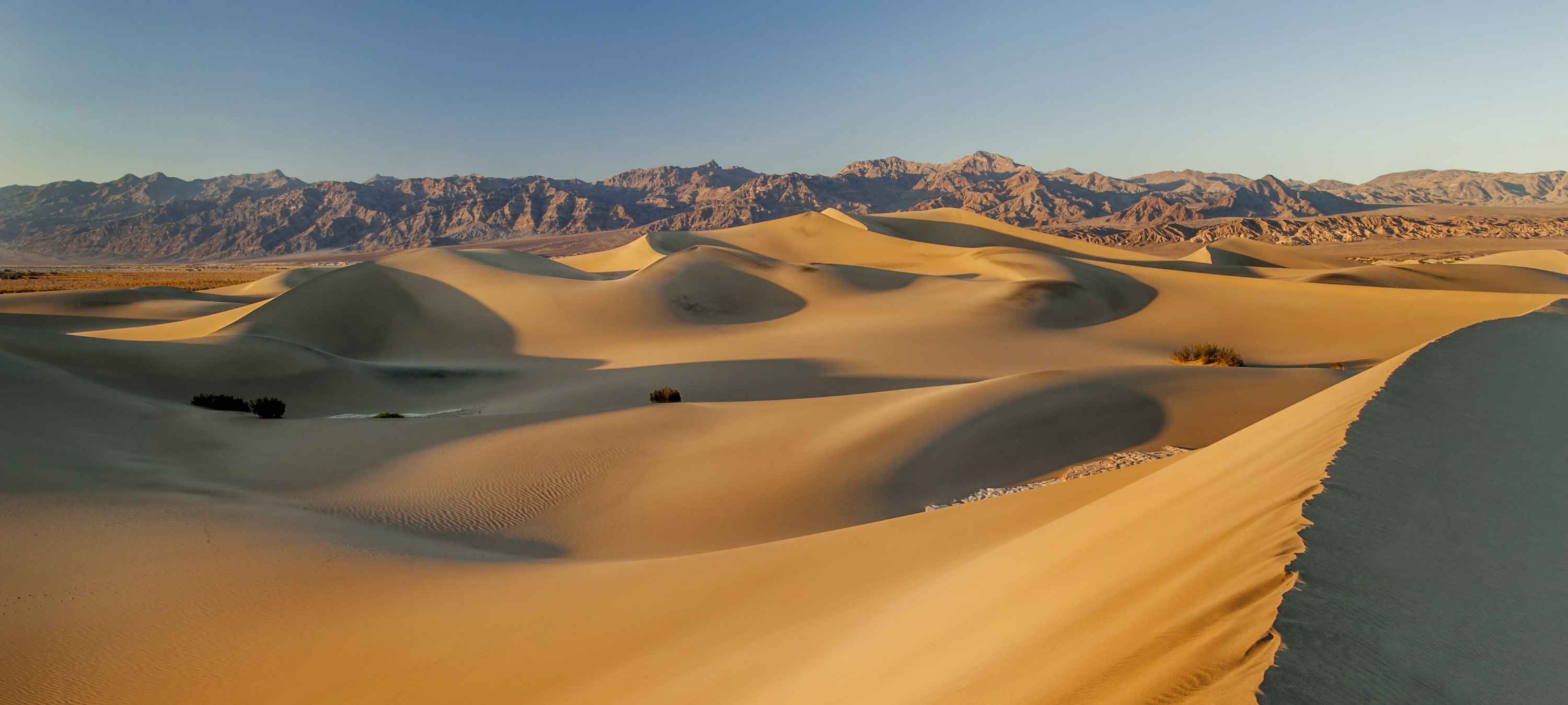Between the high energy of Las Vegas to the east and the towering trees of Sequoia and Kings Canyon National parks to the west lies Death Valley National Park. With more than 3.4 million acres, most of which are in California with a corner sticking into Nevada, Death Valley is the largest national park outside of Alaska, and the fifth-largest national park in all of the United States. That’s not to say you’ll encounter crowds when visiting the park.
In 2018, about 1,700,000 people visited Death Valley National Park, which seems like a lot until you take a look at the figures for the most-visited park: Great Smoky Mountains National Park welcomed 11,421,200 visitors last year. So, needless to say, there’s plenty of room to get away from other visitors.
On top of the enormous potential for solitude, Death Valley National Park is on people’s radar for a variety of reasons. If you’re one of them and you’re ready to plan a trip to this vast desert landscape, this will highlight the following:
- Why Visit Death Valley National Park?
- Top Destinations in Death Valley National Park
- The Top Outdoor Things to Do in Death Valley National Park
- How to Plan Your Trip
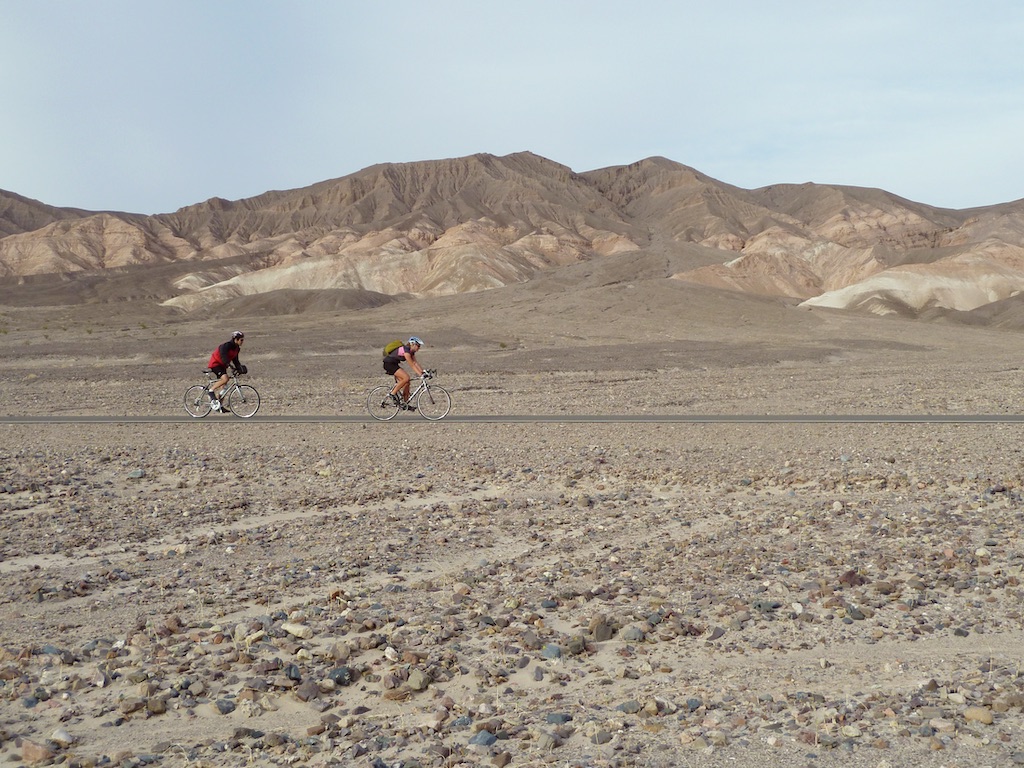
Cyclists pedal down one of the many isolated roads in Death Valley National Park.
Why Visit Death Valley National Park?
Aside from being the largest national park outside of Alaska—and the fifth-largest national park in all of the United States—Death Valley National Park holds a few more titles that make it appealing to travelers: It holds the record for hottest air temperature ever recorded on Earth, plus the driest and lowest place in North America.
In fact, the region originally got its name when, in 1849, a group of pioneers lost their way amidst the barren, unforgiving landscape. One of them gradually succumbed to the elements, and, as they climbed over the Panamint Mountains after finally being saved, one of the surviving pioneers turned back and said: “Goodbye, Death Valley.”
But despite the extremes, Death Valley National Park is a sublime destination for sun-kissed thrills in an otherworldly landscape. Whether hiking among stone enigmas, mountain biking miles of sparsely-ridden singletrack, backpacking to forgotten outposts or stargazing under the light of the Milky Way, this park is sure to quench your thirst for solar-infused adventure (but definitely bring the water).
Top Destinations in Death Valley National Park
In a park as big as Death Valley, it’s important to weigh your options, time of year, type of vehicle you have and time constraints when deciding where to go and what to do. That said, there are many places of interest to visit, including the following highlights:
Artist’s Drive
The colors of the rainbow can be seen along the 9-mile Artist’s Drive. The rock formations here are awe-inspiring, and although the drive is beautiful at any time of day, the afternoon light casts a special glow over the varying colors. Hop out of the car at the Artist’s Palette viewpoint for terrific photography opportunities.
Badwater Basin
The lowest point in all of North America is found at Badwater Basin. A short, quarter-mile walk across the salt flats will put you right at 282 feet below sea level; the polygon-shaped salt formations seen here are synonymous with Death Valley.
Mesquite Flat Sand Dunes
You can see them rising in the distance, and they certainly appear closer than they actually are. The Mesquite Flat Sand Dunes are the largest dune configuration within Death Valley National Park, and incorporate three different types of dunes: crescent, linear and star-shaped. Some of the dunes rise nearly 100 feet from the ancient lake bed floor.
Dante’s View
Set your alarm and make your way to Dante’s View to catch the sunrise over Death Valley National Park. At 5,475 feet, the view faces west to the Panamint Mountains over Badwater Basin and is one of the best vantage points in the park. On a clear day, you may even be able to make out the Sierra Nevadas on the far western horizon.
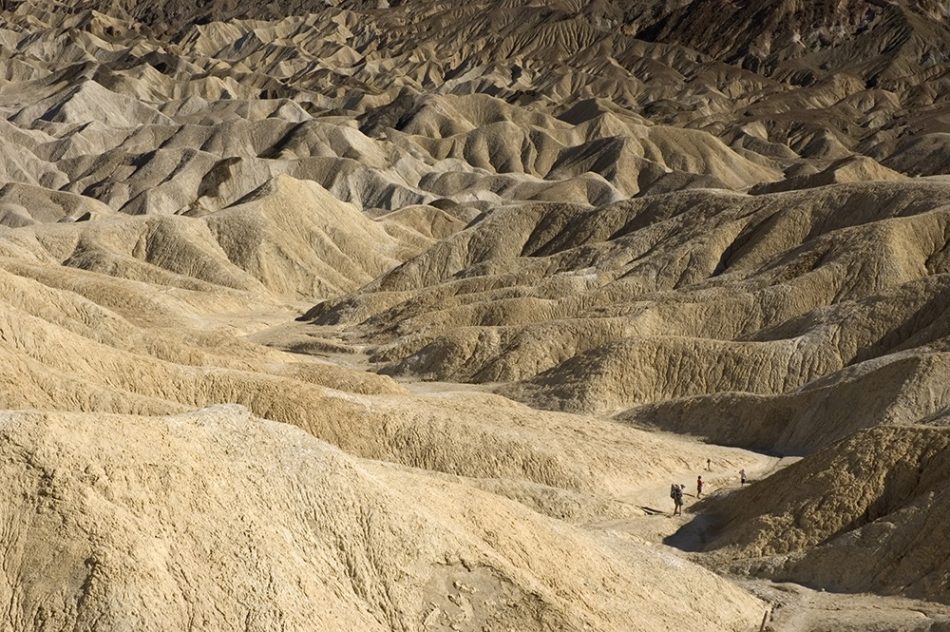
Hikers wander through an arid corner of Death Valley.
Ubehebe Crater
In the northern part of the park lies the half-mile-wide and 600-foot-deep Ubehebe Crater, possibly created as recently as 300 years ago by an explosion when magma mixed with an underground spring. During the cooler months in Death Valley (October through April), consider a hike around the rim.
Rainbow Canyon
The Father Crowley Vista Point provides a terrific view of dark lava flows intermixing with volcanic cinders, plummeting into the colors of Rainbow Canyon. Don’t be startled if you hear noise overhead—the military uses this area of the park for its jet fighter low-flight training.
The Racetrack
A nearly full-day excursion, the Racetrack is only accessible to those driving a four-wheel-drive vehicle with good tires. The destination, however, is well worth the effort. Here, in the northwest region of the park, you can see the infamous moving rocks.
Two miles south of the Grandstand parking area, park your vehicle and walk about a half-mile toward the southeast corner of the mesa for the best views of the rocks and their paths. Mystery surrounds the odd formations, which have gradually slid across the arid flats, leaving trails in their wake—some weighing as much as 700 pounds!
Top Outdoor Things to Do in Death Valley National Park
1. Hiking
More than 20 hiking trails are found within Death Valley National Park. Although the park is open 24 hours a day, 365 days a year, it is important to be prepared when setting out for a hike in this barren, desolate area. The National Park Service suggests that the best time to hike in Death Valley is from November through March, when temperatures are lower. The NPS also suggests going on low elevation hikes on cooler winter days, and heading into the higher elevations to escape summer temperatures; the peaks can be covered in snow in the winter and spring. For mellow winter outings, consider donning a pair of snowshoes. If tackling burlier winter-hiking objectives, be sure to bring winter clothing, an ice axe and crampons.
For quick, easy hikes, follow the flat half-mile Salt Creek Interpretive Trail, a loop trail that follows a boardwalk and is a terrific place to spot the Salt Creek pupfish and a diversity of bird species. The mile-long Badwater Salt Flat hike takes you out to the lowest point in North America, with views of the salt flat that stretches for more than 200 miles.
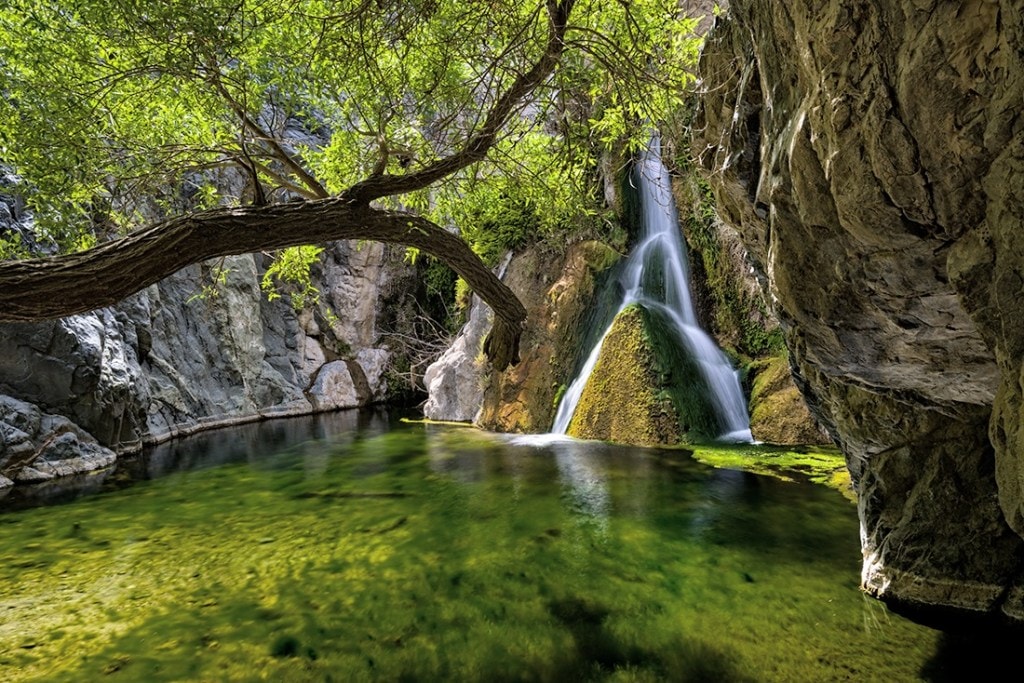
Darwin Falls supports a surprisingly lush canyon in the otherwise arid Death Valley National Park.
Craving respite from the heat? The moderate two-mile Darwin Falls hike—including a bit of rock scrambling—leads to an oasis-like sanctuary of cascades. The waterfall provides drinking water, but remember, there’s no swimming allowed. Another moderate trek is the six-mile Fall Canyon hike—you may even spot bighorn sheep.
More difficult hikes within Death Valley National Park include Wildrose Peak, an 8.4-mile round-trip hike that traverses pinyon-juniper woodlands to an elevation of 9,064 feet, with a 2,200-foot elevation gain. For an all-day hike, take on the 14-mile round-trip Telescope Peak hike to the highest point in Death Valley at 11,049 feet.
2. Backpacking
Setting off with a pack and exploring the remote areas of Death Valley National Park can be rewarding—but can also offer serious challenges and, as such, backcountry trips in the park should only be undertaken by experienced, well-prepared backpackers. Before setting out, get a free backcountry permit at the Furnace Creek Visitor Center or the Stovepipe Wells Ranger Station.
3. Road Cycling and Mountain Biking
Hop onto the saddle and experience Death Valley National Park via bike. A fun fact: All of the park roads that are open to vehicular traffic are also open to cyclists. And in addition to paved roads, there are also routes designated specifically for bicycle use. In total, more than 785 miles of roads, including hundreds of miles for mountain biking, await.
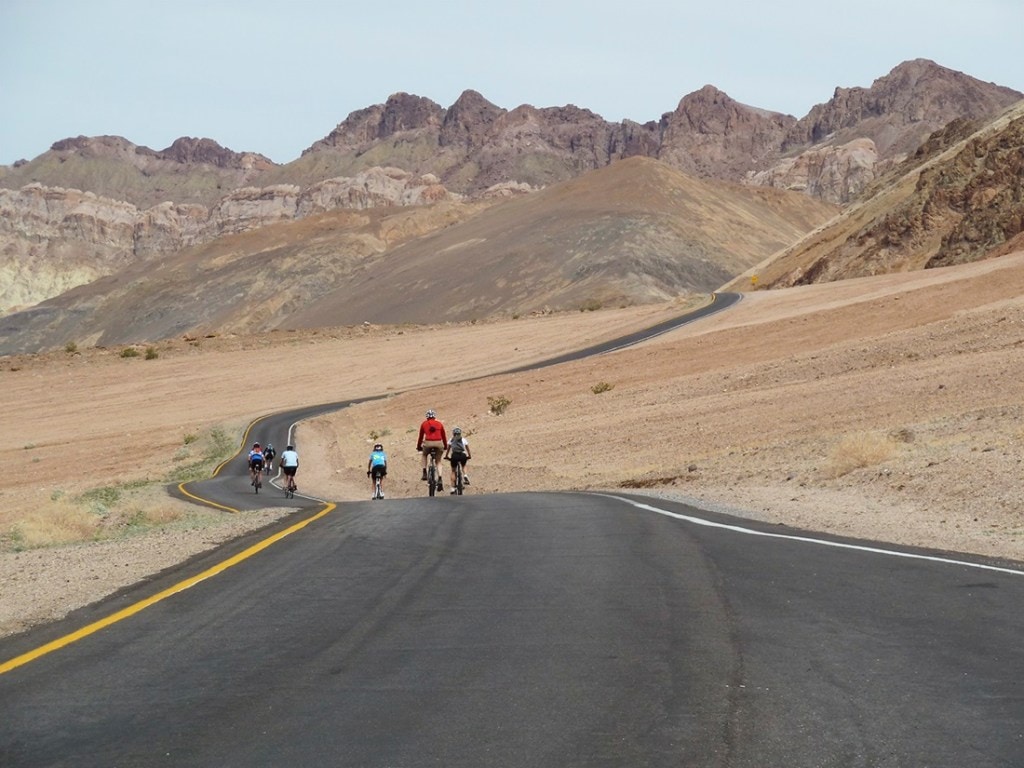
Cyclists pedal on miles of deserted road in Death Valley.
Easier rides within the park include those along Salt Creek Road and Twenty Mule Team Canyon Road, both of which are graded. For more of a challenge, go off road and take on the washboard gravel of Skidoo Road, or the loose gravel of Hole-in-the-Wall Road. While paved, the hills of the 9-mile Artist’s Drive make it a more difficult ride. For a longer, even more difficult ride, set out on the 28-mile one-way Titus Canyon Road, with steep grades and loose gravel.
4. Stargazing
The lack of light pollution in Death Valley National Park makes it a spectacular destination for stargazing. In fact, the park is the third International Dark Sky Park in the National Park System. Step outside, look up and take in the heavens while bathing in the starlight.
For gazing that’s largely unimpeded by Death Valley’s mountainous topography, head to Harmony Borax Works, which is close to the Furnace Creek Visitor Center; Mesquite Flat Sand Dunes near Stovepipe Wells; or Badwater Basin, located about 30 minutes from Furnace Creek. And for best results, visit during a new moon and bring binoculars. On a particularly clear night, the Milky Way might even make an appearance.
How to Plan Your Trip to Death Valley National Park
Best Time to Visit Death Valley
Death Valley National Park didn’t come by its name offhandedly—it’s the hottest place on Earth, and the driest place in North America. 1913 saw Death Valley’s hottest and coldest dates on record—on January 8, 1913, it dropped to 15 degrees Fahrenheit and on July 10, the thermostat rose to 134 degrees Fahrenheit. Both records were recorded in Furnace Creek.
In the summer months (May through September), the average high is 109 degrees, and the average precipitation is only 0.09 inches. The bottom line: It’s very hot and dry. That said, winter and spring in Death Valley National Park are quite pleasant, with milder temperatures and clear, sunny skies.
But despite the extremes, it’s a bit surprising just how much color can be found spanning the harsh desert landscape. Winter rains can bring swaths of stunning spring flowers; in some years, look for blooms in late-March and early-April in the lower elevations, April and May at mid-elevation, and even into June higher up in the mountains.
Whatever time of year you visit, it’s imperative to bring plenty of water with you. The National Park Service suggests drinking two to four liters per person, per day, and more if you are active in the heat. Bringing electrolyte tablets/powders is also a good idea.
Where to Stay
The Oasis at Death Valley: Located at Furnace Creek, The Oasis at Death Valley (formerly the Furnace Creek Resort) features two lodging options: the historic, deluxe Inn, built in 1927, and the 224-room, family-friendly Ranch. Camping is also available at the onsite Fiddlers’ Campground.
Stovepipe Wells Village: Some of the 83 rooms at the Stovepipe Wells Village Hotel feature views of the Mesquite Flat Sand Dunes and the surrounding mountain range. RV parking with hookups and camping is also available within the village.
Panamint Springs Resort: A variety of accommodations is available at Panamint Springs Resort in Panamint Valley. Choose from rooms within the lodge or the cabin that best suits your needs. RV parking with hookups and camping is also available at the resort.
Campgrounds: A variety of camping options are available at seven of the nine available campgrounds within Death Valley National Park. Before packing your tent, however, be sure to check with the park to see which campgrounds are currently open, as some close during the winter months. As noted by the NPS, “It is very rare for all campgrounds to fill in Death Valley … you are 99.9% likely to find a spot in the park.”
Backcountry camping is available within Death Valley National Park for those “who prepare properly and follow Leave No Trace principles.” Be sure to review the park’s backcountry camping rules before setting out on your adventure.
How to Get There
Traveling to Death Valley National Park takes time, but it’s well worth the effort. From Las Vegas’ McCarran International Airport, it’s roughly a two-hour drive, with the most direct route passing through Pahrump, Nevada and along California Highway 190, which is the main road running from east to west through the park. If you are traveling from Los Angeles, follow I-15 North to California Highway 127 North, which intersects with CA-190. The drive from L.A. averages roughly four and a half hours.
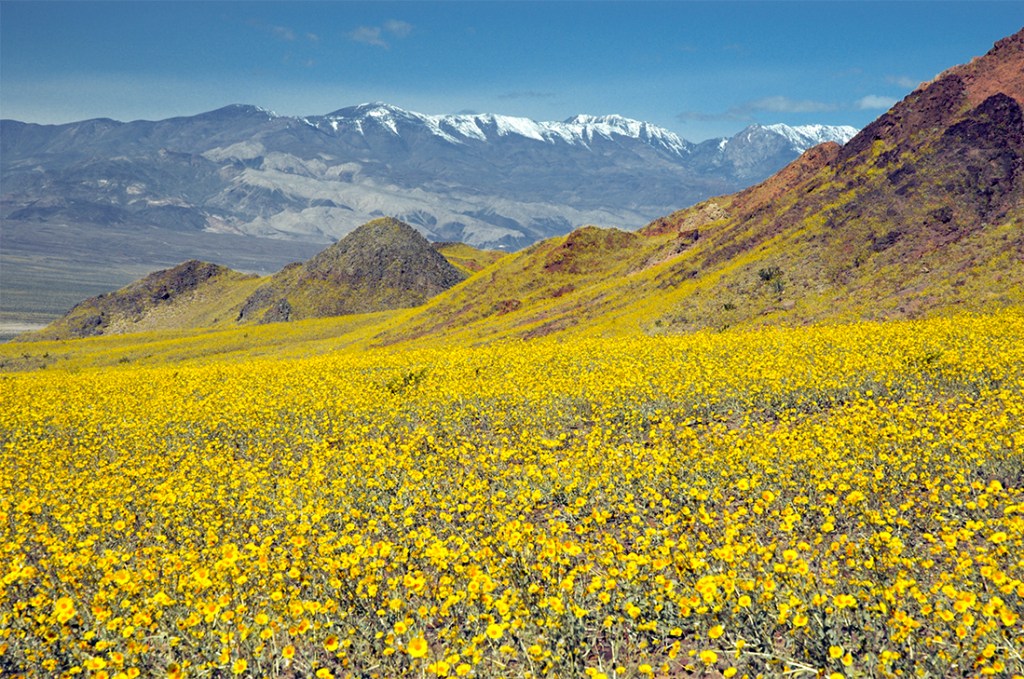
Expansive wildflower blooms can be found in the wettest of years in Death Valley; remember your camera!
Interestingly, there isn’t a specific street address for the park or the Furnace Creek Visitor Center to plug into a GPS; rather, plug in the post office address instead (328 Greenland Blvd., Death Valley, CA 92328). A word of caution: The National Park Service encourages visitors to not depend upon GPS alone, since “GPS Navigation to sites to remote locations like Death Valley are notoriously unreliable.” Rather, the NPS suggests carrying up-to-date road maps to supplement traditional GPS navigation.
If you have the means, you can also fly into the small public airport at Furnace Creek.
Visitor Center and Ranger Station
Once you’ve arrived, the Furnace Creek Visitor Center on CA-190 is the place to go to get oriented. A 20-minute film showcasing the park is shown throughout the day, and the center is fully-staffed daily (hours may vary seasonally) to help you make the most of your time in the desert region.
A second visitor center is at Scotty’s Castle in the northern portion of the park, but it (and the entire area) is closed until 2020 at the earliest, due to flood damage that occurred in October 2015. Additionally, a ranger station is found in Stovepipe Wells Village, and you can pick up information and maps there, too.
Fuel and Food
Traveling to Death Valley National Park does take some planning, including where to gas up during your visit, as there are more than 300 miles of paved roads within the park.
En route from Las Vegas, stop by the gas station in Shoshone to fill up before continuing on CA-127 to CA-190, which takes you into the park. If you miss Shoshone, continue on CA-127 towards Amargosa Valley, past the CA-190 junction—and then retrace your route to catch CA-190. Otherwise, within the park, your only options for gas are at the Furnace Creek Visitor Center Area, Stovepipe Wells Village and Panamint Springs.
Just like the gas stations, food options within Death Valley National Park are quite spread out, so you may want to bring some snacks with you to the park to satiate any last-minute cravings.
In Furnace Creek, The Oasis at Death Valley has several options, depending on what you may be hankering for. Casual breakfast, lunch and dinner are served at the 1849 Buffet in the middle of the Town Square at The Ranch, and lunch and dinner are served at The Last Kind Words Saloon. Or, grab a burger for lunch or an early dinner at The 19th Hole, adjacent to The Furnace Creek Golf Course at Death Valley clubhouse. Breakfast, lunch and dinner are also served at The Inn Dining Room at The Inn.
For quick grab-and-go, stop by the general store for groceries, or the ice cream and coffee bar for a quick pick-me-up. Also nearby is Timbisha Tacos.
In Stovepipe Wells Village, northwest of Furnace Creek, breakfast and dinner are served at the Toll Road Restaurant, or grab a boxed lunch to enjoy in the park. If you’d rather sit down for lunch, pull up a stool at Badwater Saloon and enjoy one of the saloon’s own Death Valley label beers with your meal. The General Store is your go-to for grab-and-go goods in Stovepipe Wells, with pre-made picnic nibbles, snacks and grocery staples at the ready.
To the west, Panamint Springs Resort serves a continental breakfast buffet, lunch and dinner year-round, and its bar features more than 150 beers from around the world. For quick bites, snacks are available at the General Store, as are hand-scooped ice cream cones and milkshakes, perfect for those hot desert days.
Recreating in the Desert
Death Valley National Park is a very remote destination, and cellphone service is inaccessible in most areas. Though traveling to Death Valley is available year-round, it’s important to be prepared at all times.
The National Park Service suggests staying on paved roads in the summertime, and if your car happens to break down, stay with it until help arrives. The NPS also says that summer hiking is not recommended, except in the early morning hours and in the mountains/higher elevations.
Water is very important whenever you’re active, but even more so in desert conditions. Again, the NPS suggests always bringing plenty of water, and recommends drinking at least two to four liters a day, and even more if you’re active in the heat. In the summer, those quantities jump to one gallon or more, per person, per day.
No matter what your adventure style is, there are a vast array of things to do in Death Valley National Park.
